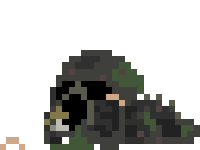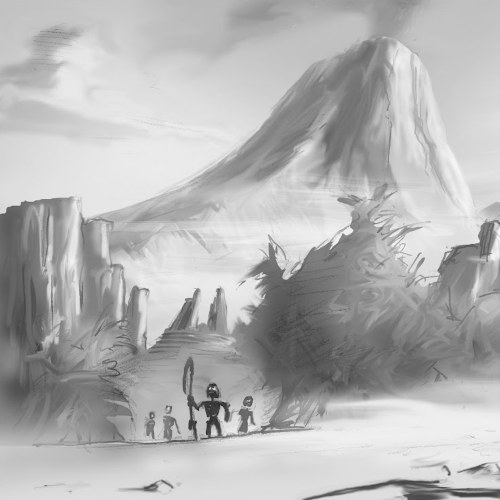
|
polynesian cultures and bionicleThis is a version of an essay I initially wrote in the fall of 2018. I first published it on my personal site 2020.07.28. Newly revised with glossary added as of 2023.04.08. In late 1999, while working to develop multiple story concepts for fledgling Lego toy themes, Bob Thompson of Lego Media sent a number of prompts for story ideas to different creative agencies, in an effort to draw in new talent. One prompt, entitled Bone Heads of Voodoo Island, reached Alastair Swinnerton, a scriptwriter. Noting the story’s Polynesian aesthetic leanings, Swinnerton decided to pull words from a Māori dictionary in order to exoticize the straightforward, descriptive character names.1 Flame, the figure with a fire sword, became Tahu2, and the other characters were similarly adjusted. This passing decision would have a lasting impact on the legacy of the toy line that would come to be known as Bionicle. But as indicated by the baldly racist Bone Heads title used by the prompt Swinnerton received, the problems with Bionicle and exoticization of the Other run much deeper than just the decision to use Māori terminology. |
|
The franchise's labored negotiation of its own appropriation of Polynesian and other cultures culminated in 2003, with the release of its first film, Mask of Light. The film, as well as the other Bionicle media contemporary to it, show that the Bionicle creators did become conscious on some level of their unconsidered usage of cultures subjugated and colonized by western powers. But the realization did not extend to addressing some of the most fundamental issues embodied by the toyline. While Mask of Light is key to this investigation, it cannot be the sole focal point. Bionicle was formulated on a model wherein “Stories on different platforms should build the overall theme, but no one presentation (e.g. comic book, online game, video game, etc.) should give you the entire story.” The media had to be fit together by the consumer like Lego bricks.3 It is impossible to talk about one aspect of Bionicle without bringing others into the conversation. Swinnerton successfully pitched back to Thompson and the rest of the Lego Group his vision for the toyline, incorporating Māori words. He was brought on to the Bionicle story team, which then expanded the usage of Māori terminology, using it for names not only of characters, but locations, animals, masks, and more. Included in the lore were powerful, god-like beings who were crucial to the formation of the island that Bionicle took place on. Two were named Papu and Rangi - the earth mother and sky father of Māori mythology (with Papu being a bastardization of Papa, presumably as the latter would not read as feminine for a western audience). Swinnerton has since stated that “if we were going to use a language, we’d better use it properly, and respectfully,” indicating the team wrote with a level of intent to respect the meaning and source of the words. He does concede, though, that "The Maoris didn’t see it that way."4 Bionicle launched in January 2001. By May, it had garnered enough attention from Māori people that three tribes were moved to organize under Maui Solomon, a lawyer who contacted Lego on their behalf. While the broad usage of Māori words and Polynesian visual trappings were points of contention, the greatest grievance brought up in the letter was Lego’s use of the word tohunga - “the Māori word for priest or spiritual healer, […] which was the name that Lego adopted for the helpless inhabitants of the fantasy tropical island.”5 Presumably, the usage of Papa and Rangi would have been cause for even greater outrage. But as coincidence would have it, the characters were only scant mentioned in any Bionicle materials released up to that point, and thus were likely not noticed by the Māori tribes. Following the initial contact from Solomon, Papa and Rangi were swiftly and completely stricken from the Bionicle record.6 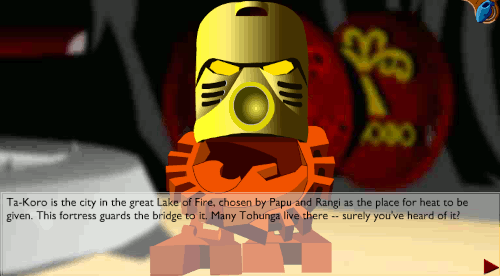 One of the only places Papu and Rangi appeared in the Bionicle story. Screen capture from the Mata Nui online game. Solomon’s call for a dialogue with Lego was quickly met by the company. As with Papa and Rangi, usage of tohunga was immediately suspended – with one significant exception that will be addressed later. It would seem to have been a happy ending - Roma Hippolite of the Ngati Koata Trust was quoted saying “We have been impressed by the willingness of Lego to recognise a hurt was inadvertently made and show that in their actions.” Lego resolved not to appropriate words from “original cultures” any longer for product names, as well as promising to “develop a code of conduct for cultural expressions of traditional knowledge.”7 Wainohia Lum-ho argues this promise falls in line with The Mataatua Declaration on Cultural and Intellectual Property Rights of Indigenous Peoples, which advises indigenous people to develop codes of conduct by which others must follow in order to utilize aspects of their culture.8 In return I would observe that this is not a case of the Māori tribes represented by Solomon providing a code for Lego to follow, as the Declaration would recommend. It is Lego stating they will, at a future point, develop a code for themselves. The distinction is important and can be felt in the way Lego would approach representations of Polynesian culture in Bionicle moving forward. I use “Polynesian culture” and not merely “Māori culture” here intentionally. While the discourses surrounding the intervention made by the Māori tribes into Bionicle largely see the encounter as one strictly between Māori culture and Lego, I believe that Bionicle’s creators were giving little regard to the actual specifics of Māori culture and beliefs. Rather, they were relying on broad, stereotypical images of Polynesian culture in general to define the toyline. This can be felt in Solomon’s initial letter to Lego. The Guardian quotes him as writing: These names and concepts are derived from Māori and Polynesian traditional knowledge. The story line bears a remarkable resemblance to the traditional stories of the peoples from Rapa Nui who are closely related to the Māori peoples. It is ... a violation of the cultural and intellectual property rights of the Māori, Hawaiian and Rapa Nui peoples." [emphasis mine]9 I am drawing on Charles W. Mills’ The Racial Contract to establish a more rigorous model for the forms of racism Bionicle embodied than the narratives that have circulated thus far. Mills comes from a philosophy background, where the idea of a “social contract” that society operates under is used as a thought experiment to model human behavior. This social contract, Mills argues, assumes an ideal society, leading to an “obfuscation of the ugly realities of group power and domination,”10 realities that not only inform but are definitional to and formative of western society. The Racial Contract is Mills’ correction to the social contract. He uses his Contract to describe the real (if unconscious) set of beliefs and assumptions leading society to be formed around white supremacy and racial subjugation.11 He is not, to be clear, describing any real or posited actual contract - no such thing exists. He is borrowing the terminology of the philosophical “social contract” to describe institutionalized racism. The core of the Racial Contract is the division of humans entirely into two groups: “white” and “nonwhite.” People constructed as white are “full persons,” while people constructed as nonwhite are “of a different and inferior moral status, subpersons.”12 This binary division also affects constructions of space, dividing it into the civil and the savage/wild/primitive. Mills uses this to account for colonization and extermination (if the space is seen as “wild,” there are no “real” people there, erasing accountability).13 We might also think about the way it flattens countless cultures globally into a singular Other to the white, western gaze. While Bionicle does not seek to “civilize” the Other or the space of the Other, it reflects a colonial exoticization of Polynesian space. The toyline is the product of white, European toy designers and advertisers who felt entitled to the usage of cultures and spaces that are not their own. Cultures that are historically and presently oppressed. At its launch in 2001, Bionicle relied on visuals of golden beaches, palm trees, jungles, and volcanos. The characters’ Great Spirit comes down from the heavens to become the island they live on, and the heroes arrive in pods that drifted through the ocean from an unknown location. These are all broad images that are not specific to Māori culture, instead reflecting a western perception of the cultural and spatial Other of Polynesian peoples. Melanie Wall writes an excellent piece that lays out multiple ways Māori people are constructed as Other in ways that are specific to their culture.14 None of these can be read in Bionicle – its mode of Othering is simply too broad. A clear example of this is in Bionicle’s application of the word haka. Haka “is the generic name for all types of dance or ceremonial performance that involve movement”15 in Māori culture, so while the term is broad, it encompasses a set and specific group of practices. The Haka of Bionicle have some broad similarities to at least some real haka - the characters assume a wide stance, and move their arms in coordination with one another. But in Bionicle these are meaningless motions simply timed to music, a blind facsimile of a casually encountered reality. Compare this to another case of western appropriation of the haka: an ad campaign by adidas featuring the All Blacks, the New Zealand national rugby team. Michelle Goris covers this campaign. She establishes that the All Blacks perform the Ka Mate haka before every game they play. In two adidas posters, All Blacks players are depicted performing the Ka Mate. They are “dressed in the official adidas All Blacks uniforms, which has the adidas logo on the right and the All Blacks fern logo on the left.”16 The juxtaposition of cultural practice and corporate patronage conflates the two, shifting the meaning of the haka from something decidedly Māori to something primarily signifying of the All Blacks, allowing the “exploitation of Maoridom” while simultaneously disguising it.17 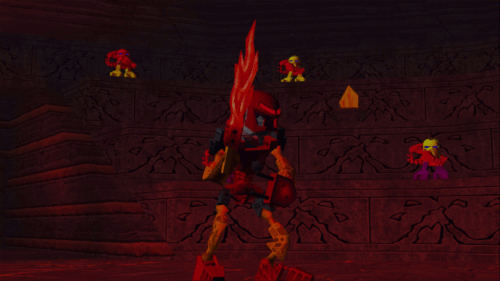 A Bionicle haka. These were renamed to 'Takara' after the Māori intervention, and were dropped from the Bionicle story after 2001. Screen capture from version .006 of the cancelled Bionicle PC game. The takeaway here for our purposes is that the appropriation on display concerns an actual depiction of an actual haka, and is thus in dialogue with the specificities of Māori culture and its complex relationship with the All Blacks. The depiction even plays into one of the specific stereotypical constructions of Māori identified by Wall: that of the Māori as “primitive natural athelete,” an offshoot of the wider imaginary of the physically powerful savage that emphasizes their “Black physicality” and translates it into prowess in sports.18 By contrast, it seems all but certain the Bionicle creators merely envisioned a generalized, stereotypical “primitive dance” and applied the word haka to it because that was the word for dance in their Māori dictionary. There is no understanding of or specific engagement with Māori culture, in either a positive or negative sense. Further undergirding this is the fact that, while many of the terms used for Bionicle were taken from Māori, a significant number were drawn from other Polynesian languages, a very clear indicator that the Bionicle creative team was regarding these cultures interchangeably. Terms were taken from Hawaiian, Fijian, Rotuman, and the language of Rapa Nui. With all this in mind, we are prepared to examine Lego’s response to the Māori intervention, and how it bore on their use of Polynesian cultures, mythologies, and terminologies in further additions to the Bionicle story and toyline. While Lego technically held true to their promise to never appropriate new terms for the names of new characters, characters from the toyline’s initial launch continued to be relevant to the story and, thus, remained on store shelves in the form of new iterations and designs year-to-year. There appears to have been at least a token effort to adjust the spellings of the names in order to separate them from their linguistic sources, but the application was haphazard and inconsistent. Some names, like Maku20 and Puku21, became Macku and Pewku. Others, like Kongu22 and Vakama23 continued to be used in the following years without any alterations. Whether or not this directly reflects the agreement between Lego and Solomon is unclear, as the terms they came to are not public. Exacerbating the issue was the case of a monthly-updated web adventure now referred to as the Mata Nui Online Game, a runaway hit that contributed significantly to Bionicle’s initial success. The game played a key role in shaping the Bionicle world, but, unfortunately, its developer Templar Games did not at the time abide by all the same rules as the core Lego company. As described earlier, almost all Bionicle media immediately ceased to use tohunga upon the arrival of Maui Solomon’s letter. The exception was Mata Nui, in which Templar continued to use tohunga through the rest of 2001, for a full six months after the term was otherwise discontinued. While Templar finally switched to using the replacement term Matoran in their productions upon that word’s introduction the following year, there was more trouble to come. In 2003, coincident with Lego introducing its new spellings of certain character names derived from Polynesian languages, the sequel to Mata Nui launched with a name for every incidental character that appeared. These names were sourced from a gamut of languages: Japanese, Albanian, Celtic languages, Hebrew, Egyptian, Romanian, and various African languages, among others. They even took a few more Hawaiian words, as well as one more from Māori. These names were not used for retail products, and thus appear to have met Lego's internal criteria for 'acceptable' use. It's a demonstration of how little things had changed, and something of a nadir of Bionicle’s cultural Othering – utilizing the “exotic” quality of the sound of other languages to a white, western, English-speaking audience, to give characters exotic, interesting sounding names – with complete and utter disregard for the context and origins of the words. They were terms to spice up a fantasy world, meaningless aside from their sound, and the easter-egg potential in googling their meaning (e.g. characters from the water village use different words for ‘water’ as their names). This was the context Bionicle’s first movie, Mask of Light, arrived in. Burned by their flagrant appropriation of Polynesian culture, the Bionicle creators were making some efforts to undo the damage they had caused. Simultaneously, though, they would continue to practice many of their initial failings – most egregiously through the Mata Nui sequel, but elsewhere too. One anonymous story team member outright denied any connection between Bionicle and Polynesian culture in 2003, saying I cannot say that I have not seen stories from, what is it called, the Islands down south, where they sailed in canoes back and forth and so on, but I would like to say in this context [the relationship between Bionicle and the Māori people] that the [Bionicle] story has absolutely nothing to do with it.24 Here again, we see the flattening of cultures into broad stereotypes (“the Islands down south”), even in the context of a denial. Other creators, particularly the ones working on the film, did not deny the connections. Among them was Bob Thompson. Thompson brought on Henry Gilroy, who would ultimately write the final version of the script. Gilroy joined onto the Bionicle team after the Māori intervention, but his own articulation of the toyline’s zeitgeist betrays that the team still relied heavily on exoticization of the other at the point he came in. “The idea is a great juxtaposition of seemingly super advanced biomechanical (and obviously synthetic) creatures living in a low-tech society, on a natural, very primitive tropical paradise island.”25 It was, in fact, Gilroy’s interest in this aspect of the line that lead to his hiring: “Bob [Thompson] and I discussed our travels, trekking into Asia and found we had a lot of philosophical similarities as far as mythology and what we liked about mythology.”26 Both creators had travelled in Asia, which here stands in for Gilroy as a shared approach to negotiating the Other. There is no inherent connection to the massive, multicultural body of Asia, and the Polynesian cultures that are only in some cases geographically located in the region of the continent. For Gilroy, though, the two can be read interchangeably, as both are myth-producing, “primitive” zones outside of white, western spaces. Mask of Light marked the culmination of the first story cycle planned for Bionicle.27 It would be the last significant media artifact produced for the toyline to be set on the tropical island setting it had debuted with. While it is difficult to ascribe the specifics of intentionality with any degree of certainty, it seems to me that Mask of Light was produced with the intention of being a transition piece, one final story steeped in Polynesian imagery before the narrative moved safely away to a different space. In the story, the islander Takua28 accidentally discovers the fabled and titular Mask of Light. He is then sent on a quest by his village elder to find the mask’s owner, a legendary hero who will finally save the island from series villain, Makuta.29 Along his quest, Takua learns the importance of responsibility and standing up for others, and ultimately discovers that he himself is the hero foretold in legend. He dons the Mask of Light and becomes Takanuva,30 confronting and defeating Makuta. 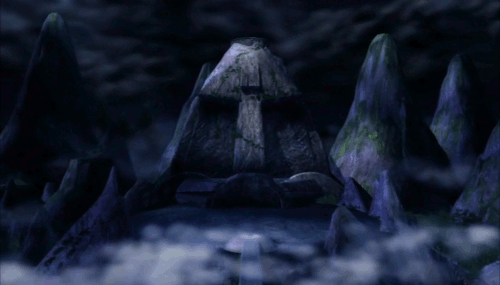 The moai of the great temple. Still from Bionicle: Mask of Light. Gilroy’s statements above highlight an important aspect of Bionicle – the characters are cyborgs, identified by the team as being “biomechanical.” While this was true from the start, Mask of Light became the first story medium to truly visualize this, layering the character designs with robotic skeletons, organic muscle, and tissue under the armor shells. The fact that the Bionicle characters as cyborgs become most visible in this film is quite apt if we read these cyborg bodies as inscribed with the tensions of the toyline’s moment. On the one hand, there is an effort to address the concerns raised by the Māori intervention. A selection of the film’s characters use the updated names, and the island’s settings are more evocative of generalized fantasy locales in their movie renditions than they are anything expressly “Polynesian.” On the other hand, the film absolutely continued to rely on the exoticizing of the Other. Many names are not changed, and those that are are phonetically identical – rendering the difference when viewing the film illegible unless subtitles are turned on. Certain locales still ring Polynesian, like the temple in the center of the island dominated by a giant stone face – a Bionicle moai emerging from the ground. The air villagers, living in the jungle, play drums to communicate over long distances; a generalized image of “primitive” communication. The characters’ bodies, then, could be said to be sites of this collision, simultaneously enacting and (attempting to) reject exoticization, two contradictory impulses smashed together into a new form, a composite, a cyborg. This culminates in the film’s conclusion, where Takanuva and Makuta merge into a single being. A cyborg of cyborgs, this ultimate form knows “the will of [the Great Spirit],” which includes revealing the new location that will replace the tropical island space in the story moving forward: hidden deep underneath the island, in a massive cavern, lies a futuristic city that is the lost homeland of the islanders. The film ends on this cliffhanger. As the story continues in other mediums, the islanders proceed with a mass evacuation to the city, abandoning the tropical island forever. They exit the space of the Other, with “primitive” villages dotting an untamed, “wild” environment, and enter the space of the “civil”: a city, the height of developed, western space. This may have partly been a move on the Bionicle creators’ part to shift to a locale where they would not run the risk of continued exoticization/racialization, but in so doing they reproduce the binary of space Mills describes as ordering the world under the Racial Contract. Rather than examining why they were treating the island space the way they were, the Bionicle creators retreated to a western, white-constructed space that could be safely depicted without controversy. But this transition is heralded by the supercyborg of the film, with all his tensions and contradictions. He knows the way to Bionicle’s de-exoticized future, but he knows it through the will of the Great Spirit, reinscribing exoticization of nonwestern religion and beliefs. 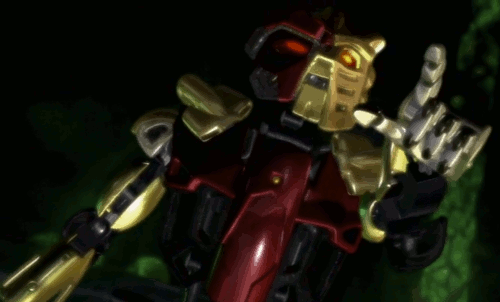 The fusion points the way to civilization. Still from Bionicle: Mask of Light. This instability in the transition is reflected in its outcome. While the story would take place in a city now, the Polynesian words appropriated at the toyline’s inception continued to be used for the characters they were initially assigned to. And, although it would be a last gasp of this mode of operating, Lego would even introduce six characters as toys for the first time that adapted some of the names from the Mata Nui sequel. Only slight changes of spelling were once again made to dispel fear of legal ramification. For Bionicle’s creators, the escape to the city was the end of the story. But the spectre of the toyline’s cultural appropriation would follow it all the way to the end, with even the short-lived 2015 reboot resurrecting many of the Māori words that were first taken in 2000. I have argued that Lego’s racism as expressed through Bionicle is a matter not solely of Māori cultural appropriation, but of wider appropriations that flatten and generalize numerous cultures. I want to close by saying that this certainly does not mean Bionicle has not had an effect on Māori people specifically. That three tribes organized a response to Bionicle is indicator enough of this, but it is also important to note that while that story had a “happy” ending with an out of court settlement between Solomon and Lego, this was not the end for all Māori people. In September 2001, a Māori individual registered as “Kataraina” on a Bionicle fan site, BZPower. Disgusted with Bionicle fans’ flippant usage of Māori words, they engaged with multiple members and posted several topics asking that use of Māori words cease. An excerpt: Our language was forbidden the use to us in schools. We got beaten for it. We saved our language from extinction 25 years back with an innovative programme adopted by many other cultures who were slaughtered by probably your ancestors. And now something so precious to us and central to our culture is mocked and demeaned by pathetic people role playing and playing games.31 Kataraina highlights the extreme injustice and hypocrisy inherent in the entitlement to Māori and other cultures’ words exhibited by Bionicle. The terminology is seen as free for westerners to use as they see fit, even as, historically, the owners of the language had it violently denied to them. It is this pilfering, which extends beyond words to images, mythologies, and culture, that Bionicle was guilty of, not merely the careless usage of a handful of words. And it is because of the Bionicle creative team’s failure to see this that their move to fix the mistakes they had made, through Mask of Light and other mediums, fell short of what was called for to truly make reparations. glossaryAs a companion to this piece, I've assembled a glossary of terms taken by Bionicle. Click to view. footnotes1. Alastair Swinnerton, “Bionicle – my actual part in its origins,” Alastair Swinnerton, Septemper 7, 2015, Link. ^Click to go back up^ 2. Tahu. “To burn” or “to set on fire.” I am grateful to Skye Barnick for sourcing many of these translations. ^Click to go back up^ 3. Kelly McKiernan, “A Visit to Creative Capers,” BZPower, September 17, 2003, Link. ^Click to go back up^ 4. Swinnerton, "origins." ^Click to go back up^ 5. Wainohia Lum-ho, “Exploitation of Polynesian Spiritual Imagery in the Toy Industry,” HONOHU 11 (2013): 16. ^Click to go back up^ 6. Swinnerton, "origins." ^Click to go back up^ 7. Lum-ho, “Exploitation,” 17. ^Click to go back up^ 8. Ibid. ^Click to go back up^ 9. Andrew Osborn, “Maoris say Lego has no right to use their words,” The Guardian, May 31 2001, Link. ^Click to go back up^ 10. Charles W. Mills, The Racial Contract (Ithaca: Cornell University Press, 1999), 3. ^Click to go back up^ 11. Ibid. 6-7. ^Click to go back up^ 12. Ibid. 11. ^Click to go back up^ 13. Ibid. 50. ^Click to go back up^ 14. Melanie Wall, “Stereotypical Constructions of the Maori ‘Race’ in Media.” New Zealand Geographer 53, no. 2 (1997). ^Click to go back up^ 15. Steven J. Jackson and Brendan Hokowhitu, “Sports, Tribes, and Technology: The New Zealand All Blacks Haka and the Politics of Identity,” Journal of Sport and Social Issues 26, no. 2 (2002): 128. ^Click to go back up^ 16. Michelle Goris, “Adidas, the All Blacks, and Maori Culture: Globalization and the Reformation of Local Identites,” Thesis, University of Oregon, 2013: 31. ^Click to go back up^ 17. Ibid. 38. ^Click to go back up^ 18. Wall, “Constructions,” 42. ^Click to go back up^ 19. Swinnerton, “origins.” ^Click to go back up^ 20. Maku. From Māori, “rainy” or “wet.” ^Click to go back up^ 21. Puku. From Rapa Nui, “rock” or “boulder.” ^Click to go back up^ 22. Kongu. From Māori, “cloudy.” ^Click to go back up^ 23. Vakama. From Fijian, “burn.” ^Click to go back up^ 24. Benedikte Brincker, Clash of Communities: A Study of the LEGO product Bionicle, Paper presented at the EMTEL Conference, 23-26 April 2003, London School of Economics, London, Link. ^Click to go back up^ 25. Jenna Glatzer, “Interview with Henry Gilroy,” Absolute Write, Link. ^Click to go back up^ 26. Ibid. ^Click to go back up^ 27. McKiernan, “Visit.” ^Click to go back up^ 28. Takua. Origin uncertain, possibly an original word created by Lego after the Māori intervention that merely ‘matches’ visually and sonically the Polynesian words they did use. ^Click to go back up^ 29. Makuta. From Māori Makutu, a set of practices described in western sources as evil witchcraft. ^Click to go back up^ 30. Takanuva. Original word, portmanteau of Takua and another original word used elsewhere in Bioncle, Nuva ^Click to go back up^ 31. “Maori Opinions on BZPower,” BZPower, November 6, 2002, Link. ^Click to go back up^ |
|
